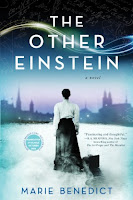Her Hidden Genius, by Marie Benedict (Sourcebooks, 283 pp, 2022, $26.99)
Rosalind, not Rosy
Every biologist knows of Rosalind Franklin, the woman crystallographer with a PhD in Physical Chemistry who 'helped' discover the molecular structure of DNA (deoxyribonucleic acid), the chemical compound we study in college genetics courses.
The year was 1953 - the Nobel Prize was later awarded to three male discoverer-scientists, in 1962, but not to Franklin. She had died four years previously possibly due to radiation she used regularly in the lab. At that time, it was still not unequivocal that radiation could have such deleterious results and, in addition, many scientists did not like having to wear a radiation indicator or adhere to strict protocols that slowed them down. Franklin was no exception (although cancer did seem to run in her family as well).
Two Kinds of Scientists
Some scientists are inordinately meticulous and do not communicate discoveries until they have plenty of unambiguous proof while others are theorists who make great mental leaps of faith and publish before they are 100% certain. Watson and Crick may have been the latter while Franklin was most likely a member of the former type of scientists and that may have led to her unhappiness and lack of success, in addition to being female in a world populated with males.
But, perhaps even more ammunition for a novel or creative nonfiction, is the fact that in the 40s and the 50s and the 60s, not all women scientists were fully accepted by their male peers. Author Marie Benedict has again written a scintillating scientific novel - scintillating in that this reviewer knew the story of the discovery of DNA's structure from The Double Helix by James Watson and from scuttlebutt in graduate school, yet raced to finish the book to find out the why and how it happened (the what was already known).
Major characters include James Watson, an American post-doc; James Crick, a British researcher; Maurice Wilkins, an administrative scientist; and Rosalind Franklin, a British researcher who was skilled in technique; with minor characters being Linus Pauling, a researcher in the US, and his son, Peter, a scientist who comes to England.
The Race is On!
So close and yet so far. Everyone is theorizing the structure of DNA but must prove it with data that is just now being obtained. Watson and Crick build a 2-stranded helical model after Pauling's 3-stranded helix is found to not explain all the data. But could Watson and Crick be sure they had it right, before publishing? One theory has Watson and Crick visiting Wilkins and spying the photographic proof lying on Franklin's desk in plain sight during a lunch break.
Others think Franklin (or her student), who took the photo, simply didn't recognize what she saw.
And others still believe Franklin had written the paper with her work as proof of the structure but had not yet submitted the paper for peer review. Nevertheless, other related papers of hers were also published in the journal issue that published the Watson-Crick model.
You will learn that it actually (or not) took about seven years for the scientific community to fully accept the DNA structure.
And the Answer is. . . .
To find out why Franklin was not awarded the Nobel Prize in 1962 with Watson, Crick and Wilkins, you have to read the book. It is a page-turner even if you know how it ends.
Author's Style
Whichever version you believe of the discovery of the structure of DNA, it is wise to read both versions - Watson's Double Helix (non-fiction) and this book, Benedict's novel, Her Hidden Genius. As a matter of fact, I usually recommend Watson's book and sometimes require it in my college biology classes but I am also considering adding Benedict's novel.
This reviewer was mesmerized by The Only Woman in the Room, about Hedy Lamar and her escape from Nazi Germany and invention of frequency hopping which led to the GPS systems we all know and use. (Review here.)
Then I read The Other Einstein (review here), a second best novel.
Although interested in the books about Clementine Churchill and Carnegie's maid and Agatha Christie, I'm not sure I will pick them up - Her Hidden Genius was a tad bit slow and failed to show any growth in the main character. She seemed to have a chip on her shoulder all the way through. In addition, we were never part of the book - it didn't happen to us: instead we were told what happened rather than experiencing what happened.
Nevertheless, reading The Double Helix and Her Hidden Genius might provide great discussions for a college class of non-biology majors (and although Her Hidden Genius has a few explanations of the science, they are not crucial to the story.)




No comments:
Post a Comment